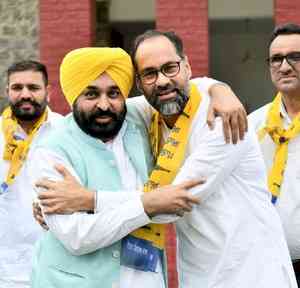Gandhi as seen through the lens of traditional Indian artists
Author(s): City Air NewsRuchi Ghanshyam, High Commissioner of India in London, along with Amish Tripathi, noted author and Director, Nehru Centre, officially inaugurated the traditional art exhibition on the life and legacy of Mahatma...


Ruchi Ghanshyam, High Commissioner of India in London, along with Amish Tripathi, noted author and Director, Nehru Centre, officially inaugurated the traditional art exhibition on the life and legacy of Mahatma Gandhi, curated by Export-Import Bank of India.The exhibition being held to commemorate Gandhi’s 150th birth anniversary, is open at Nehru Centre, London, from October 2 to 11, 2019.
Seventh edition of Exim Bank of India’s traditional paintings exhibition travels to London
Mumbai, October 3, 2019: Mohandas Karamchand Gandhi first set foot in London in 1888, when he came to the city to study Law. However, the city had more in store for him. The city not only groomed him as a budding lawyer, but also as an activist and a writer. He came across people like Annie Besant and Madame Blavatsky, who shaped his conscience before he came to be known as the Mahatma to the people of India. He visited the city several times, however, the most prominent and also his last visit to London was in 1931, to attend the Second Roundtable Conference, when he was photographed standing in a dhoti and shawl at No. 10 Downing Street.
This iconic photograph of Gandhi showing his simplicity and leadership is stunningly captured in a beautiful pattachitra painting by Smt. Bijaya Laxmi Swain of Puri, Odisha. This pattachitra, along with 24 other traditional paintings from across India, are a part of a traditional art exhibition in London to mark the 150th birth anniversary of Mahatma Gandhi.
This traditional art exhibition on the life and legacy of the Mahatma, is being jointly organised by the Export-Import Bank of India (Exim Bank) with The Nehru Centre, London and the High Commission of India in London. The exhibition was inaugurated today (October 2, 2019) on the 150th birth anniversary of Mahatma Gandhi by Ruchi Ghanashyam, High Commissioner of India in London and Amish Tripathi, eminent author and Director, Nehru Centre London. It will remain open for the public till October 11, 2019 at The Nehru Centre.
The painting exhibition titled ‘Relive the Ideals of the Mahatma through Art’ will provide insights to the residents of London about some milestone events from the Mahatma’s life The exhibition provides a retrospect on some historical events and highlights important lessons from Mahatma Gandhi’s life. The exhibition in London is the seventh in a series of similar exhibitions organized by Exim Bank to observe the 150th birth anniversary of Mahatma Gandhi. The first exhibition in the series was held in Delhi and inaugurated on the death anniversary of Mahatma Gandhi on January 30th (Martyrs’ Day). The second exhibition was held on the death of anniversary of Kasturba Gandhi on February 22nd at the Aga Khan Palace in Pune. The third in the series was held at Sabarmati Ashram in Ahmedabad, coinciding with the anniversary of Dandi March. The fourth and fifth exhibitions coincided with India’s Independence Day, and were held at the Victoria Memorial Hall, Kolkata and Visva-Bharati, Santiniketan. The sixth exhibition was held in mid-September at Mani Bhawan, Mumbai.
The exhibitions have together received more than 25,000 visitors from across the world who have appreciated the paintings in traditional art forms. An art enthusiast from Sydney, Australia, Martin Coxell, remarked, “Wonderful tribute to a remarkable man,” after seeing the paintings at Pune. Nirmal Pandey, a historian from New Delhi, said, “The idea to present 12 different traditional Indian art forms on the theme of Mahatma Gandhi under one room in itself is commendable.” Naresh Gulati, an Ahmedabad-based art critic commented, “The good thing is that the works are accompanied by a narration highlighting the characteristics of the origin and style of the art forms deployed by the artists of the series, some of which are just mesmerizing for the minutiae and detail.”
The painting exhibition is unique because of the creative process that was involved. Exim Bank had engaged traditional artists from different nooks and corners of the country to develop these paintings, based on various events from Mahatma Gandhi’s life. The artists commissioned for the project developed 25 exclusive paintings representing 12 different traditional art forms [hailing from Dahanu in Maharashtra (for Warli painting), Kotra Sultanabad near Bhopal in Madhya Pradesh (for Gond painting), Kamrup in Assam (for North East weaving), Chandanpur in Odisha (for Pattachitra painting), Srinagar in J&K (for Papier Mache art), Triplicane in Tamil Nadu (for Tanjore painting), Mathura in Uttar Pradesh (for Sanjhi craft), Paschim Medinipur in West Bengal (for Pattua painting), Srikalahasthi in Andhra Pradesh (for Kalamkari painting), Ahmedabad in Gujarat (for Mata-Ni-Pachedi), Bhilwara in Rajasthan (for Phad painting) and Madhubani in Bihar (for Madhubani painting)].
On the genesis of the idea about the paintings, Nadeem Panjetan, Chief General Manager, Exim Bank, said, “We shared the concept about the project and left it to the artists to develop the paintings according to their own interpretation of important events from Mahatma Gandhi’s life. All the paintings have a story to tell and the artists worked on them for over two months. The paintings reflect the aspirations of the common people of India, who played the most significant role in Gandhi’s journey from a lawyer to the Father of the Nation.”
On the question whether traditional Indian paintings are losing ground to modern paintings and arts across various other mediums, he said, “There is a huge global market for traditional Indian paintings. We need to market them properly. It is Exim Bank’s endeavour to provide a bigger platform to these traditional Indian art forms.”
The exhibitions are non-commercial events and the paintings on display are solely for the purpose of educating the audiences about the life and legacy of Mahatma Gandhi, through various traditional Indian art forms. Exim Bank believes in promoting all round development of the Indian economy and endeavours to support enterprises and artisans based out of rural areas of the country. Exim Bank has over the years supported artisans under its grassroots initiatives and market advisory services programmes, to secure domestic and export orders for their handicrafts and traditional products.

 cityairnews
cityairnews 















